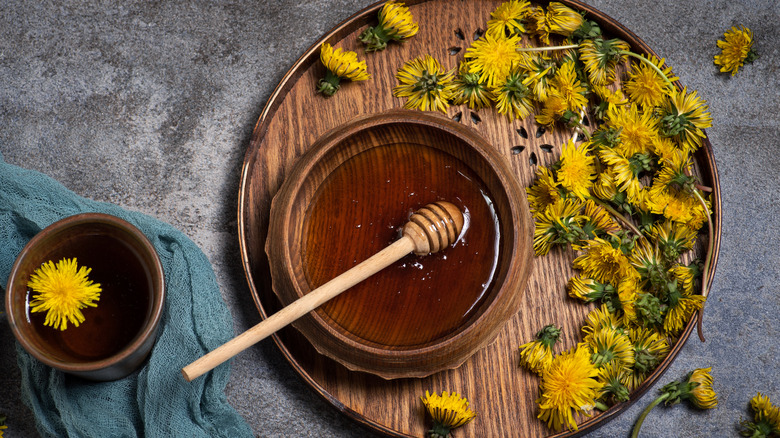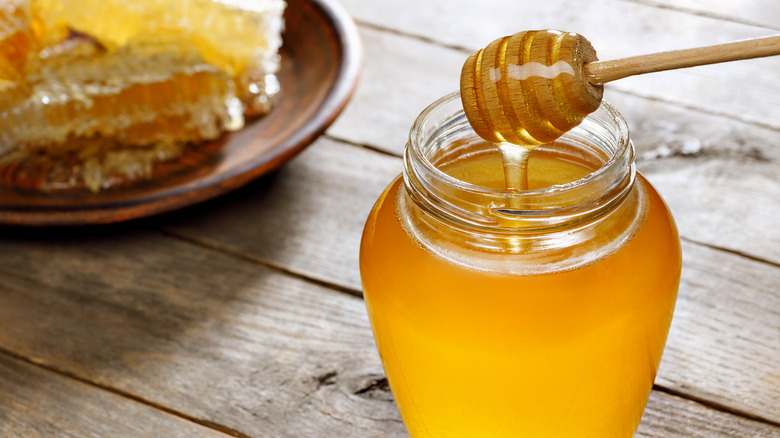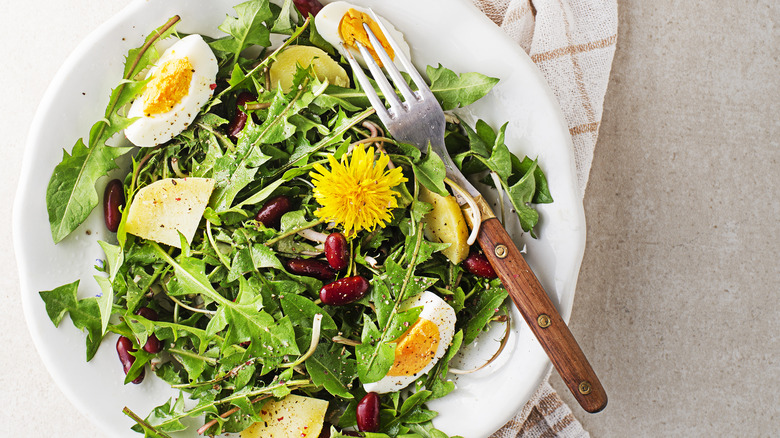What's The Taste Difference Between Dandelion And Bee Honey?
Honey is an ingredient with such strength of character, it's hard to imagine substitutes. But vegans, and those with honey allergies, have had to find swappable ingredients like agave, maple and date syrups. And while some dandelion honey is made by bees, you can create or find a version that is a sweetened syrup flavored with dandelion, making it a popular alternative thanks to a flavor profile reminiscent of regular bee honey. If you've had French dandelion jelly, you may already know it somehow tastes like honey, and this is similar.
While the taste of dandelion honey is reminiscent of the traditional stuff, its distinctive character is thanks to the source flower. Unsurprisingly it's often described as floral, but this amber-colored liquid sweetener can even be interpreted as nutty and at times a little bitter (dandelion greens are so notably bitter that they're often used for digestive purposes). Dandelion honey can have tea-like qualities, like notes of chamomile, and even a touch of tartness. Because dandelion honey is made by humans, it is usually also thinner (and mouthfeel impacts flavor, too), while bee honey is naturally thicker and more concentrated, resulting in a richer, rounder body across the board. But for both products, taste can be dependent on other factors.
Flavor notes of different honeys
The taste of both dandelion honey and traditional bee-made honey can vary based on a number of factors. Bee honey offers an entire spectrum of flavors, from floral and fruity to grassy and herbaceous. Some honeys are even considered "funky" or (contrary to its sweet identity) even a bit bitter. The source of the pollen is what makes the difference, and whether it's acacia or orange blossom, clover or wildflower, honey has terroir.
Similarly, the flavor of dandelion honey is impacted by environmental factors, like when and how the flowers are collected. Dandelions bloom in spring and are at their peak during the day. If you're making your own dandelion honey, it could be fun to experiment with flowers collected at different times and stages of seasonality.
Dandelion honey recipes also often call for lemon or apple (the pectin in the fruit can contribute to viscosity) or even vanilla, the flavors of which will influence the finished product. And because homemade dandelion honey is technically a syrup, the type of sugar used will also impact flavor, whether that's granulated white sugar, brown sugar, or a blend. When you make it yourself, there are many other ways to manipulate the taste within the framework of your recipe, too.
Flavoring and using your dandelion honey
An added benefit to dandelion honey is that you can make it yourself — no apiary necessary — and in doing so, infuse flavors. You can keep it sweeter or skew more to the bitter side by retaining some of the green parts of the flower. Add herbs like rosemary, or other aromatics like lavender or rose petal — or even fennel for a more savory element. You can substitute orange or another citrus for lemon, pear for apple if your recipe calls for these fruits, or even make it a spin on hot honey by including habaneros or other spicy peppers. You can also control the viscosity and mouthfeel of your finished product, reducing longer for a thicker version or leaving it on the looser side, depending on your needs and plans for use.
Like bee honey, dandelion honey is versatile in the kitchen. Mix it into a honey lime vinaigrette (and drizzle on a Dandelion Greens With A Fried Egg, Croutons, And Anchovy Dressing). You can bake with this sweet stuff too, and add a little flair to shortbread cookies or cakes. Whip it into a sweetened butter for a perfect addition to biscuits with flakey sea salt or banana bread. Dandelions are useful in so many ways, from honey to wine and beer, this so-called weed has a whole lot to offer.


